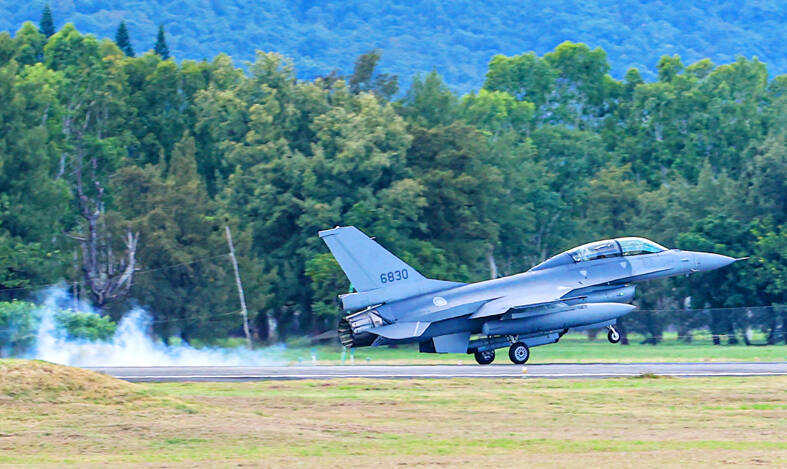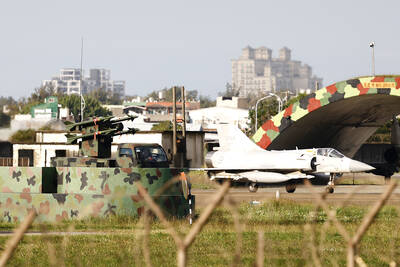The US Department of Defense has identified four possible military courses of action that China could take against Taiwan, but did not offer any guess on when Beijing might be ready to act.
In an annual report to the US Congress released on Tuesday titled Military and Security Developments Involving the People’s Republic of China 2022, the department gave a broad overview of China’s military capabilities, strategy, ambitions and intentions.
The report devoted significant space to developments related to Taiwan, against which it said China had intensified diplomatic, economic, political and military pressure last year.

Photo: CNA
For example, the Chinese People’s Liberation Army (PLA) conducted 20 naval exercises simulating the capture of Taiwan last year, up from 13 a year earlier, it said.
Chinese warplanes, including advanced J-16 fighters, entered Taiwan’s air defense identification zone on 240 days last year, it said.
China now has a range of military courses of action it can take against Taiwan, which vary in feasibility and risk, and can be divided into four general categories, the report said.
First, China could attempt to impose an air and maritime blockade to cut off Taiwan’s vital imports, possibly accompanied by missile attacks or the seizure of Taiwan’s outlying islands, in an effort to force its capitulation, the report said.
This would also likely be complemented by electronic warfare, network attacks and information operations “to further isolate Taiwan’s authorities and populace, and control the international narrative of the conflict,” it said.
Second, Beijing could conduct “limited force or coercive operations,” it said.
In this scenario, China would use “computer network or limited kinetic attacks” against political, military or economic infrastructure to induce fear and degrade the confidence of Taiwanese in their leaders, the report said.
In such an operation, PLA special operations forces could also “infiltrate Taiwan and conduct attacks against infrastructure or leadership targets,” it said.
Third, an air and missile campaign involving precision strikes against key government and military targets to degrade Taiwan’s defenses, “neutralize” its leadership or undermine the public’s resolve to resist might be used, the report said.
Fourth would be an actual invasion of Taiwan, it said.
The invasion tactics China would most likely adopt would be a joint island landing campaign, the report said.
That concept envisions a complex, coordinated campaign to establish a beachhead, build up combat power on Taiwan’s shores and seize key targets across the nation, it said.
While China is continuing to build and rehearse these capabilities, a large-scale amphibious invasion is “one of the most complicated and difficult military operations” and would likely strain China’s armed forces and invite international intervention, the report said.
“Combined with inevitable force attrition, complexity of urban warfare and potential insurgency, these factors make an amphibious invasion of Taiwan a significant political risk for [Chinese President] Xi Jinping (習近平) and the Chinese Communist Party, even assuming a successful landing and breakout,” it said.
Nevertheless, the Pentagon believes that China is already capable of amphibious operations short of a full-scale invasion, such as an invasion of Pratas Island (Dongsha Island, 東沙群島) or Itu Aba Island (Taiping Island, 太平島), or of the better-defended islands of Kinmen and Lienchiang counties, it said.
However, even a limited operation would involve significant “and possibly prohibitive” political risks, because it could galvanize independence sentiment in Taiwan and generate powerful international opposition, the report said.
The report did not set out a timeline on when China might take such actions, although it said that China’s goal of accelerating the integrated development of its military by 2027 could give it “a more credible military tool ... to wield as it pursues Taiwan unification.”

Taiwan is gearing up to celebrate the New Year at events across the country, headlined by the annual countdown and Taipei 101 fireworks display at midnight. Many of the events are to be livesteamed online. See below for lineups and links: Taipei Taipei’s New Year’s Party 2026 is to begin at 7pm and run until 1am, with the theme “Sailing to the Future.” South Korean girl group KARA is headlining the concert at Taipei City Hall Plaza, with additional performances by Amber An (安心亞), Nick Chou (周湯豪), hip-hop trio Nine One One (玖壹壹), Bii (畢書盡), girl group Genblue (幻藍小熊) and more. The festivities are to

Auckland rang in 2026 with a downtown fireworks display launched from New Zealand’s tallest structure, Sky Tower, making it the first major city to greet the new year at a celebration dampened by rain, while crowds in Taipei braved the elements to watch Taipei 101’s display. South Pacific countries are the first to bid farewell to 2025. Clocks struck midnight in Auckland, with a population of 1.7 million, 18 hours before the famous ball was to drop in New York’s Times Square. The five-minute display involved 3,500 fireworks launched from the 240m Sky Tower. Smaller community events were canceled across New Zealand’s

‘IRRESPONSIBLE’: Beijing’s constant disruption of the ‘status quo’ in the Taiwan Strait has damaged peace, stability and security in the Indo-Pacific region, MOFA said The Presidential Office yesterday condemned China’s launch of another military drill around Taiwan, saying such actions are a “unilateral provocation” that destabilizes regional peace and stability. China should immediately stop the irresponsible and provocative actions, Presidential Office spokeswoman Karen Kuo (郭雅慧) said, after the Chinese People’s Liberation Army (PLA) yesterday announced the start of a new round of joint exercises around Taiwan by the army, navy and air force, which it said were approaching “from different directions.” Code-named “Justice Mission 2025,” the exercises would be conducted in the Taiwan Strait and in areas north, southwest, southeast and east of Taiwan

‘SLICING METHOD’: In the event of a blockade, the China Coast Guard would intercept Taiwanese ships while its navy would seek to deter foreign intervention China’s military drills around Taiwan this week signaled potential strategies to cut the nation off from energy supplies and foreign military assistance, a US think tank report said. The Chinese People’s Liberation Army (PLA) conducted what it called “Justice Mission 2025” exercises from Monday to Tuesday in five maritime zones and airspace around Taiwan, calling them a warning to “Taiwanese independence” forces. In a report released on Wednesday, the Institute for the Study of War said the exercises effectively simulated blocking shipping routes to major port cities, including Kaohsiung, Keelung and Hualien. Taiwan would be highly vulnerable under such a blockade, because it